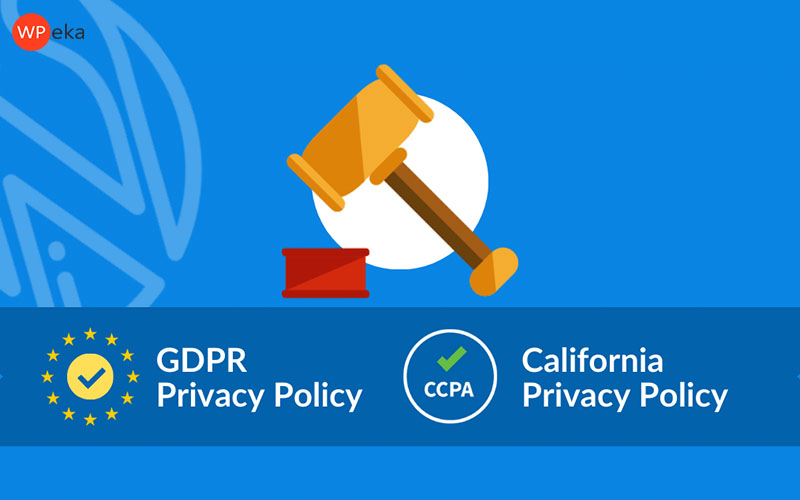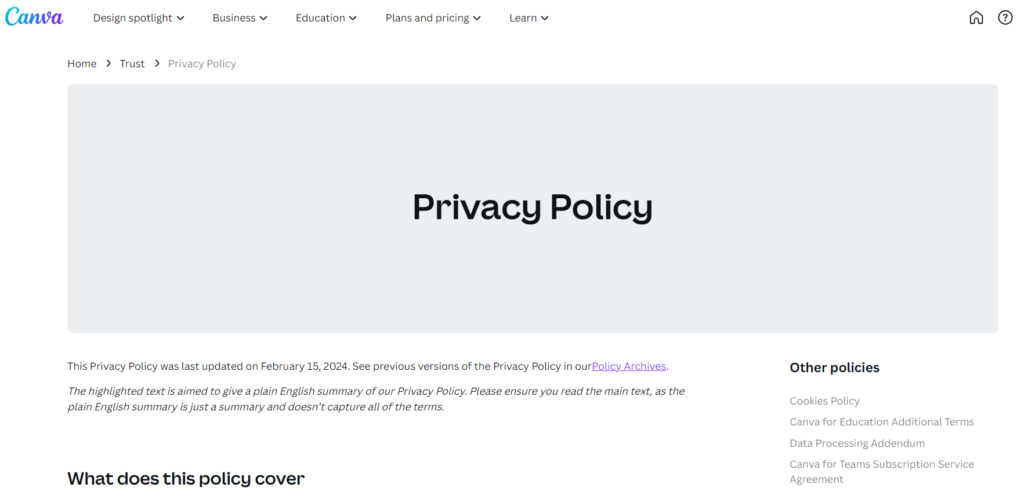Are you planning to write a privacy policy for your website?
A privacy policy is a legal document that discloses what personal information your website collects from your visitors.
As a website owner, you must figure out how to write a privacy policy because of the strict rules worldwide.
In this article, we will learn how to draft a privacy notice for your website and the best practices you should follow for writing a privacy policy as a website owner.
What is a Privacy Policy?
A privacy policy is a legally binding document that describes users’ rights regarding the gathering, sharing, processing, and safeguarding of user data on a website.
A privacy policy helps you comply with legal requirements and promotes trust among visitors or customers.
Having a privacy statement on your website guarantees the safety of your client’s data and also helps to maintain your online reputation.
Many countries have solid legal requirements for websites, and these rules vary based on your users’ location. Here are some of the well-known laws.
- General Data Protection Regulation (GDPR): The GDPR is an EU regulation requiring websites that handle the personal data of EU citizens to have an open privacy policy explaining data handling and security measures.
- California Consumer Privacy Act (CCPA): Under the CCPA, you must disclose to Californian website visitors how you collect, use, and share their personal information.
- Other Laws: Data protection laws and regulations exist in different nations and regions. You must know these rules and regulations if your website caters to a worldwide audience.
A clear and legally acceptable website policy is a best practice and a legal requirement.
Why is it important to have a Privacy Policy for a Website?
If you engage in any online business, mainly if your company is in a highly regulated industry, you must have a thorough policy on your website.
For instance, the General Data Protection Regulation (GDPR) law, passed in Europe, governs data privacy. It imposes severe penalties on businesses that violate its requirements.
The GDPR applies to only businesses outside Europe and the European Economic Area (EEA) that conduct business there.
The Personal Information Protection and Electronic Documents Act (PIPEDA) governs Canada’s use, disclosure, and collection of personal data.
Although the USA lacks a specific federal data privacy law like GDPR. It has several independent national and state laws and acts that have been implemented to guarantee privacy compliance.
Some of the USA’s governing bodies include The Federal Trade Commission, which enforces the Children’s Internet Privacy Protection Act, or COPPA. Also, they have laws like the California Consumer Privacy Act, or CCPA, which addresses California’s consumer protection and privacy rights.
These laws mandate that commercial websites and online services provide a privacy statement for websites.

You can create a privacy policy in many different ways. For example, you might need the help of a lawyer, or you might create one manually, but that can be tedious and time-consuming.
That’s where a solution like WP Legal Pages comes in.
WP Legal Pages is a free privacy policy generator for WordPress websites. It is a powerful WordPress plugin that makes it simple for website owners to create extensive legal policies, including website privacy statements.
You don’t need to be a legal expert to build a professional and compliant privacy policy when using WP Legal Pages.
The plugin has an easy-to-use interface and a guided wizard that walks you through each procedure.
Benefits of WP Legal Pages
Let’s take a closer look at the benefits of the WP Legal Pages plugin.
- Announcement Banner for Privacy Policies: This banner appears whenever your legal pages are updated or changed.
- Age Verification Popup: This popup ensures that visitors to your website are of legal age to view the content.
- Cookie Consent Bar: Informs visitors about the cookies you use and the information you collect.
- Quick Setup Wizard: The guided wizard user interface simplifies the process by assisting you as you add the necessary elements to your policy pages.
The WP Legal Pages plugin makes creating and managing legal documents on your WordPress website easier.
How to Write a Privacy Policy Manually?
To write a privacy policy page for a website, you should consider the following steps to ensure the document is effective and legally compliant.
Step 1: Data privacy laws
First, find out which laws apply to your business and familiarize yourself with all the guidelines and specifications about your privacy and processes.
Step 2: Disclose which information is collected
Specifying the types of personal information collected from users, including payment and financial information, IP addresses, and email addresses, is essential.
Step 3: Data collection method and usage
Your privacy policy must describe your data collection procedures. In compliance with regulations such as the GDPR and CCPA, you must also disclose how you use personal data, including whether it is shared or sold to third parties.
Step 4: Reason for collecting personal data
You must show and document the legal reason for each personal data you gather.
Step 5: Procedures for security and safety
Your privacy policy should include a section explaining how you plan to securely and safely keep users’ personal information compliant with regulations such as the GDPR and the amended CCPA.
Step 6: Updates to privacy policies
A section in your privacy policy should outline how you will inform your clients of any changes to the policy.
Step 7: Include any more appropriate clauses
Include any other policy link to your privacy policy, like:- terms and conditions.
Step 8: Contact Information
Provide users with a list of ways to contact your business if they have any inquiries or privacy-related worries. You can set aside a department or email address for privacy-related matters.
Step 9: Data Retention
You must include a data retention clause in every database to allow users to generate unique accounts or subscriptions. Users should also be advised that the database may retain certain personal information even if they delete their accounts and subscriptions.
You must include the following privacy policy points while manually drafting the policy.
What to Include in a Privacy Policy?
The following is an overview of the critical points of what a privacy policy should include.
- Complete Details: The policy should start with clearly identifying the website owner. If this is a person, then you should include their full name.
- Policy’s effective date: Indicate the date the policy takes effect. Today marks the official date that the privacy policy terms have become legally binding under privacy laws.
- Customer Data Collected: Users’ concerns over data collection methods are growing. To foster mutual respect and confidence, a company should disclose its data-collecting practices and the types of information it collects.
- How the data is used: A company must be open and honest about collecting client data.
- Any Tracking Tool Used: Identify your website’s tracking technology to collect user information. Although using web trackers is allowed, businesses must nonetheless follow regulations.
- Opt-out clause: By utilizing an opt-out clause, users can choose to have their information removed or withdrawn from the company’s data collection processes. Opt-out is also known as consent withdrawal.
Now that you know the contents of a privacy statement, let’s examine the best practices for writing a good privacy policy.
Privacy Policy Examples

Airbnb has a straightforward and uncomplicated approach to its privacy statement. This thorough privacy policy is short and crisp. They keep it concise and include helpful information for quick reading.
They’ve also included their other company policies link in the sidebar to make it easy for you to refer to them.
This open and honest attitude facilitates building trustworthy relationships with Airbnb’s clients.

Canva has crafted a comprehensive privacy policy that covers every aspect of why and how it gathers and handles user data.
It has avoided using complex language throughout its privacy policy to reassure customers that their data is secure.
Canva has highlighted summary parts that are easier to skim rather than read word for word.
FAQs:
How to write a privacy policy for an eCommerce website?
Writing a privacy policy for an eCommerce website requires you to specify the kinds of information gathered through your store and the purpose for data collection, recording, storage, and deletion.
What is a privacy policy template?
A privacy policy template is a pre-made, legally approved policy template that can be customized to meet your business needs by answering the questions.
How to create free privacy policy?
To create a free privacy policy, use a privacy policy page generator like WP Legal Pages. It will help you create your policy in a few minutes.
Conclusion:
We hope this guide has helped you understand how to write a Privacy policy For Your Website.
Remember to adhere to applicable data privacy laws, explain it clearly, and post it in several accessible places across your website.
Start writing superior privacy policies for effectiveness and clarity using WP Legal Pages.
Download the WP Legal Pages privacy policy template, answer the question, and make necessary changes.




